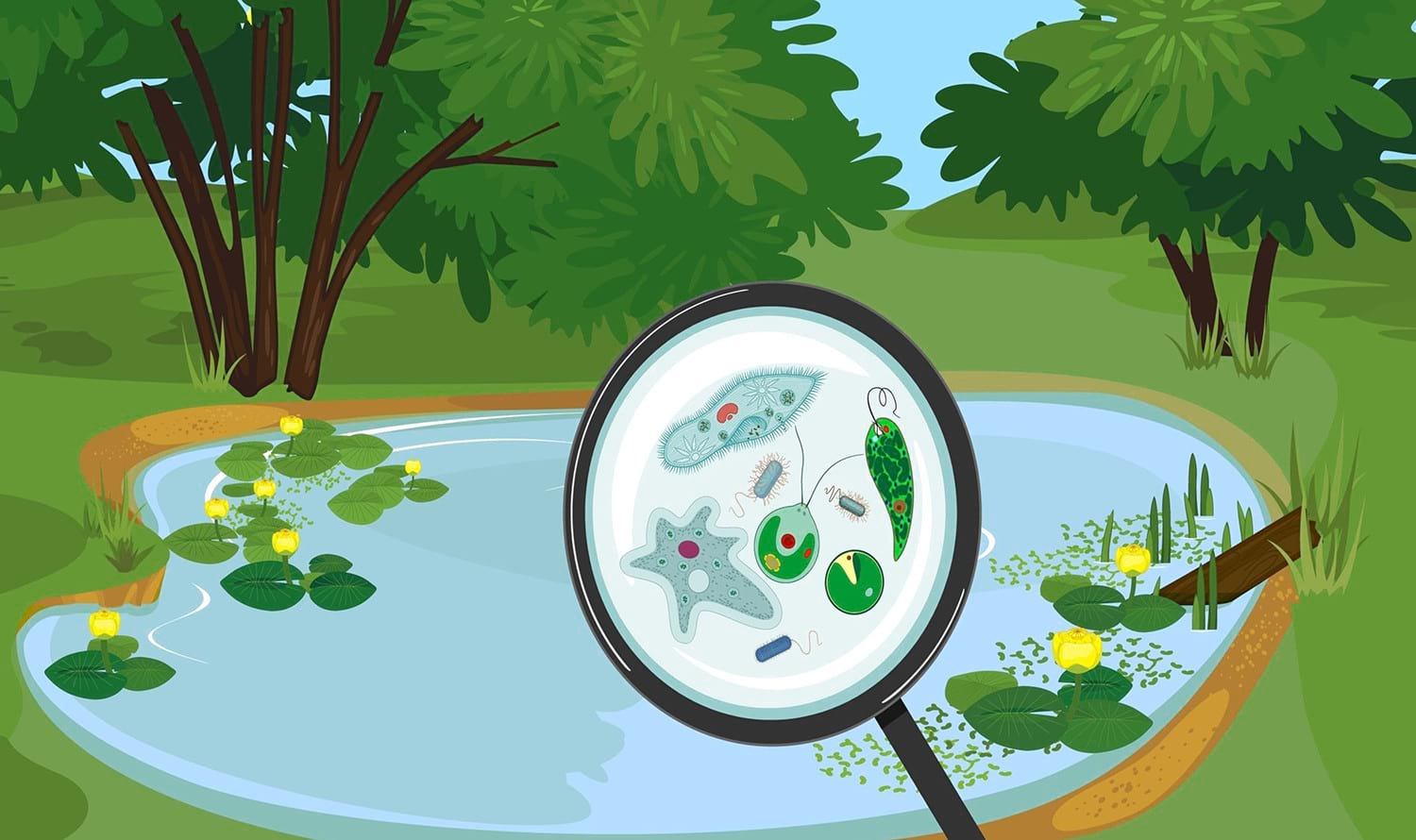Any functioning ecosystem, including a pond, needs bacteria to sustain life and maintain a balanced ecosystem.
Bacteria are microscopic single-celled organisms measured in microns (one millionth of a meter), ranging from 1 to 10 microns in length and 0.2 to 1 microns in width. In ponds, bacteria break down organic waste and debris, which helps keep the water clean and healthy for any fish or plants that reside in it. They also convert that debris into much-needed nutrients to help support life.
They may be out of sight and out of mind for many pond owners, but these beneficial bacteria are essential to the life and health of any pond.
Types of Beneficial Bacteria in Ponds
A properly maintained pond will create an ecosystem that supports the presence of beneficial bacteria. These bacteria are split into two categories based on the environmental conditions under which they can function: aerobic and anaerobic bacteria.
Aerobic Bacteria
Aerobic bacteria require oxygen to grow and live, so they thrive in oxygen-rich environments. These bacteria digest organic compounds at a much higher rate than other types of bacteria, quickly breaking down sludge like dead plants, fish and animal droppings, algae, leaves, food, and other organic debris that has fallen into the pond and recycling the nutrients. Another important function of aerobic bacteria is the transformation of deadly ammonia into nitrites and then into nitrates, which are absorbed by pond plants.
In turn, these processes prevent the buildup of organic matter at the bottom of the pond, which helps reduce odors and maintain clear, healthy water.
Aerobic bacteria are found closer to the surface of the pond where there are higher levels of oxygen.
Anaerobic Bacteria
Decomposition doesn’t stop due to a lack of oxygen; there are bacteria ready and waiting to digest organic matter in all environments.
Anaerobic bacteria cannot exist in the presence of oxygen, so they are found in parts of the pond that have little to no oxygen. These bacteria digest organic compounds slower than aerobic bacteria, and they release hydrogen sulfide and carbon dioxide as by-products—which can accumulate year after year and, even in small amounts, be lethal to fish. However, they also release nutrients such as phosphorous into the water, which are a food source for plants and algae that, in turn, produce oxygen for the pond.
These bacteria are also responsible for removing nitrates from the pond by turning nitrates into nitrogen gas.
Since they are so slow at decomposing organic matter, anaerobic bacteria cannot keep up with the work of digesting all the nutrients that fall to the areas of the pond that are depleted of oxygen. Unfortunately, unless aerobic bacteria have a high enough supply of oxygen to function and take more of the decomposition workload, anaerobic bacteria are on their own.
Anaerobic bacteria often live at or near the bottom of the pond, where there are low levels of oxygen or none at all.
Relationship Among Types of Pond Bacteria
Contrary to popular belief, both aerobic and anaerobic bacteria need one another in order to maintain a properly functioning ecosystem.
As aerobic bacteria quickly and efficiently handle the work of decomposing organic matter, they reproduce at an exponential rate—which means they soon use up the available oxygen and run out of food. That’s where anaerobic bacteria play an important role: They may be slow at digesting organic compounds, but they release nutrients that pond plants and algae use as a food source. The plants and algae then produce oxygen, which helps restore the depleted oxygen levels that aerobic bacteria need to survive.
Additionally, these beneficial bacteria perform a biological filtration process called denitrification. While aerobic bacteria absorb ammonia and turn it into nitrates, anaerobic bacteria transform those nitrates into nitrogen gas, which can then be released into the atmosphere.
How to Promote the Growth of Good Bacteria
While both aerobic and anaerobic bacteria are essential to a pond’s lifecycle, anaerobic bacteria are often so slow that organic debris gathers at the bottom—the area of the pond where they thrive due to the lower levels of oxygen—faster than they can decompose it. An overaccumulation of anaerobic bacteria waste also gives off a bad smell that can sicken fish.
Therefore, to attain clean, healthy water, pond owners need to promote the growth of aerobic bacteria while hindering the production of anaerobic bacteria.
Provide a Source of Oxygen
One way of encouraging the growth of aerobic bacteria is to provide the oxygen they need to thrive at all layers of the pond. Using a mechanical aeration system, fountain, waterfall, or air pump, pond owners can ensure that oxygen is present throughout the pond and that the biological activity in the pond is maintained by aerobic bacteria.
Shallower ponds can be aerated by a fountain or waterfall, while ponds deeper than six feet may require a diffused aeration system. These additions will circulate the layers of the pond while also infusing oxygen into the water column.
Find Supplemental Aeration Solutions
With higher oxygen levels, beneficial pond bacteria will be more productive and consume the muck at the bottom of the pond. Aeration systems circulate the water in the pond, disrupt surface tension, and infuse oxygen into the water—leading to cleaner water, fewer odors, and reduced algae.
If you are interested in maintaining a healthy pond environment, the experienced professionals at ILM Environments can help you determine the best solution for aerating your pond or maintaining your current aeration systems. Contact us today to schedule a consultation.




